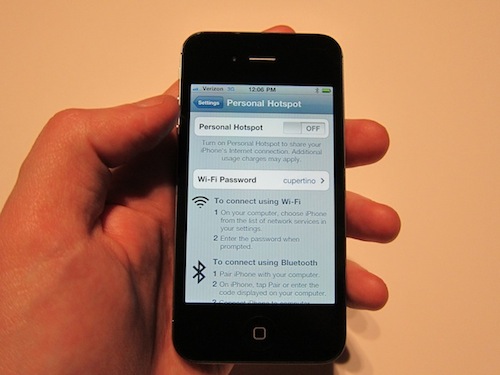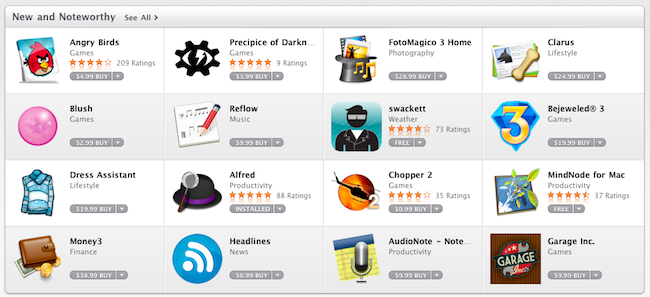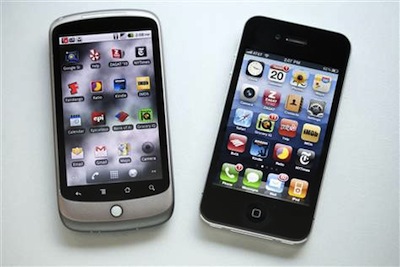With the Verizon iPhone, Apple today showcased a new software feature that comes pre-installed with the slightly-redesigned device: Personal Hotspot. Already available for several Android devices running on Verizon’s network and made deeply integrated into iOS with a new software build, Personal Hotspot will allow you to create a mobile WiFi network to share your 3G connection with up to 5 nearby WiFi devices. The feature, put simply, looks great: you can activate wireless tethering with literally two taps and a password, or go with Bluetooth and USB tethering. As suggested by Apple’s Phil Schiller himself, Personal Hotspot makes for a great alternative to popular MiFi hotspots and will allow iPad owners to carry around an iPhone on Verizon’s network and have constant access to the Internet even if the iPad is WiFi-only. Read more
Posts in stories
Verizon iPhone, Personal Hotspot and MyWi - Which One?
The Verizon iPhone Is For App Lovers
Let’s state the obvious, Fink. Geez. I’ll be blunt: this is an, “Should I keep my Android phone or get the new iPhone on my Verizon contract?” post. Specifically, I’m talking to my fellow Android owners who’re on the fence about switching to the Verizon iPhone.
I’ve been sitting on this article all day between five thousand or so words of rant material, iPhone gawking, Android squawking, and just about every title under the sun that would attract more iPhone and Android fanboy rage than my little heart could handle. Good grief! I told Federico that this piece could do me in for a few days – this one was hard to write. “Ticci!” I said. “This is too controversial for the Internetz! They’ll explode!” After much deliberation I decided to focus on one specific aspect of Android and the iPhone, instead of comparing the platforms as a whole (there’s simply too much to talk about). After dramatically toning down the content, today’s topic is all about apps and the phones that have them, but which one is better for you?
As someone on Verizon who’s had a year long matrimony with an Android… do you dare click the read more link? I think you should.
CoverSutra: A Fistful of Dollars
Developer Sophia Teutschler is having a hard time trying to deal with her most popular application for the Mac, CoverSutra, becoming a Mac App Store exclusive. As we discussed here, the latest CoverSutra 2.5 version is only available in the Mac App Store at $4.99, instead of the $20 it used to be on Sophia’s website. The problem is, years ago Sophia promised to customers who bought a license for CoverSutra 2.0 that they would get the 3.0 upgrade for free; CoverSutra’s development slowed down, Sophia got involved in more projects and won an Apple Design Award in the meantime, Apple introduced the Mac App Store. CoverSutra 3.0 isn’t out yet, but the 2.5 version is a paid app in the Mac App Store. Clearly, that is not the free upgrade until 3.0 Sophia once promised.
This is a very serious issue that doesn’t originate specifically from Sophia, but provides a good example when looking at CoverSutra because of the way Sophia decided to handle things. As you may be aware of, Apple is not offering trials, upgrade policies and existing customer migration on the Mac App Store. You can release apps, for a price or for free. That’s it. You have been selling apps on your website all this time? Good for you. But there’s no way to migrate people who already bought a license to the new Store. Read more
Mac App Store: Easy Installation of Apps On All Your Macs. Goodbye, DMG.
With the Mac App Store, as promised by Apple, you can buy apps once and install everywhere. As long as you make sure all the computers you’re willing to install apps on are your personal Macs (and you’re not trying to pirate apps that don’t come with proper receipt validation), you can purchase apps on your first Mac, and then pass them along to as many machines as you want. From a user perspective, this is just great – although it sort of kills the concept of “family licenses” we were used to in pre-App Store days. Read more
Mac App Store Impressions: Elegant, Some Apps Are Expensive, Others Suck
Today’s a pretty hectic day. Apple officially launched the Mac App Store as part of OS X 10.6.6 a few hours ago and mostly everyone in the Mac community is now playing around with the new Store, busy installing paid and free apps, trying to find what’s already good and what could have been done a lot better.
After a few purchases, free downloads and some minutes spent to get used to the new UI brought by the Mac App Store, we have some first impressions to share. Read more
Is Skype The Biggest Threat To Apple’s FaceTime?
Last night, Skype released a major new version of their iPhone and iPod touch client. Version 3.0 of the Skype app, released just in time for New Year’s Eve, adds video calling to all iOS devices with the possibility to run the app in compatibility mode on the iPad and receive video calls on screen. The iPhone app allows you to receive and initiate video calls both on WiFi and 3G, it’s compatible with iPhone 4 / iPhone 3GS and iPod touch 4th gen and, when on 3G, consumes around 3.4 MB of data per minute. Previous tests showed that Apple’s FaceTime technology also consume 3 MB per minute. Skype 3.0 also lets you call desktop users on Mac and PC and check on their computer screens (sounds useful for remote troubleshooting or networking), requires iOS 4 and supports both portrait and landscape modes.
The latest Skype update is, put simply, a huge win for the millions of Skype users out there who have an iOS device always connected to the internet. We could argue on the 24/7 internet availability on devices like the iPod touch and the iPad WiFi, but there’s no doubt the new Skype for iOS is the closest thing Apple ever had to a FaceTime competitor. Forget the 3rd party apps in the App Store that allow video calls: this is Skype. Which leads me to consider Apple’s position in regards to this update: Skype lets you see your friends wherever you are, no matter what kind of connection you’re on. Apple, due to technology limitations or AT&T’s pressure, only lets you FaceTime on WiFi. But looking at the big picture, that’s not really what Apple should fear. Read more
Going Back To Windows Has Taught Me I Could Live Off A Chrome Notebook
This is a bit of an off beat story for MacStories, but I’d like to talk about my experiences from moving to the Mac onto a PC desktop I’ve tossed together in the past week. It irks me that even going into 2011, you still see the age old arguments of software availability, familiarity, and often other non-issues when people partake in with the Mac vs. PC debate. I’d like to discuss software availability, because this is where I think PC advocates are highly mistaken in their perception of what we have available on OS X.
Short URLS Suck, OS X & iOS Malware To Become More “Sophisticated” According To McAfee
When short URLs first arrived on the scene, I was rather excited at the prospect of simply using a good looking “designer” URL to vainly share links on Twitter. Short URLs provide brand reassurance: MacStories, Engadget, Gizmodo, TechCrunch, and other sites now sport custom short URLs that verify the links we share lead back to our site. However, links from Bit.ly, CloudApp cl.ly links, and Twitter’s t.co links have become nothing more than a nuisance. If I use a service like TinyGrab, I know their short URLs will most likely lead to a snapshot someone has taken of their material. With more anonymous (everything) URL shorteners, there’s no way to verify its trust without using software that allows you to preview the long URL before you click through. We’ve seen their validity ruined plenty of times on Twitter through various attacks such as the cross-site request forgery attack that amused us for a few hours earlier this year, but I’ve simply lost trust in these “brands.”
While I didn’t need McAfee to be skeptical of weird Twitter users asking me if I want a free iPad, they predict short URLs will continue to annoy the tech savvy as the computer-illiterate continue to click through short URLs to whatever tomfoolery exists on the other side. McAfee’s other big claim: OS X could be the next target for malware kiddies.
Why Apple Doesn’t Care About The $75 Android Phone
An article published by Seth Weintraub over at Fortune last week made the rounds of the Internet detailing how the Android platform will “explode” next year thanks to relatively low-cost components. Broadcom has announced a new 3G HSDPA chipset called BCM2157 that allows for popular specs like Bluetooth, GPS, dual core ARM processors, 5MP cameras and capacitive displays. Broadcom is marketing this new chipset to Android OEMs. And the best part, according to Handset Line of Business for Broadcom Jim Tran? Phones built on the new chipset will retail under $100, possibly even touching the $75 price point. And we’re talking about retail prices of unsubsidized phones. That would allow “average users” who don’t normally spend hundreds of dollars on smartphone to buy a high-end Android phone and runs apps on it. Read more










